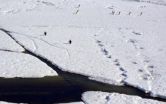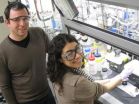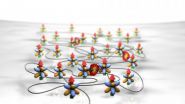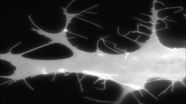(Press-News.org) The Ross Sea, a major, biologically productive Antarctic ecosystem, "clearly will be extensively modified by future climate change" in the coming decades as rising temperatures and changing wind patterns create longer periods of ice-free open water, affecting the life cycles of both predators and prey, according to a paper published by researchers funded by the National Science Foundation (NSF).
To make their predictions, the researchers used information drawn from the Regional Ocean Modeling System, a computer model of sea-ice, ocean, atmosphere and ice-shelf interactions.
While conceding that "predicting future changes in ecosystems is challenging," the researchers note in a paper published in Geophysical Research Letters, the changes predicted by the computer model have the potential to create "significant but unpredictable impacts on the ocean's most pristine ecosystem."
The wind and temperature changes, the authors note, will affect the ecological balance at the base of the Antarctic food web--including changes in distributions of algae, shrimp-like krill and Antarctic silverfish--which, in turn, may be expected to cause disruptions in the upper portions of the food web, including penguins, seals and whales, which depend on those species for food.
A team of four researchers from the Virginia Institute of Marine Science (VIMS) at the College of William and Mary and the Center for Coastal Physical Oceanography at Old Dominion University in Norfolk, Va., jointly authored the paper.
Walker O. Smith, Jr., a professor at VIMS and the lead author of the study, said: "The model suggests that the substantial changes in the physical setting of the Ross Sea will induce severe changes in the present food web, changes that are driven by global climate change. Without a doubt the Ross Sea 100 years from now will be a completely different system than we know today."
The research was funded by the Polar Programs (awards: 0838948 and 0944254) and the Ocean Sciences divisions in NSF's Geosciences Directorate.
The U.S. Antarctic Program (USAP) coordinates all U.S. research on the Southernmost Continent and in the Southern Ocean as well as providing the necessary logistical support for that science. NSF manages the USAP.
The researchers note that over the last 50 years the distribution and extent of Antarctic sea ice, or ice that floats on the ocean surface, have drastically changed. Among these changes are a documented decrease of sea ice in the Bellingshausen-Amundsen sector, but an increase of sea ice in the Ross Sea sector of Antarctica.
Observations show, they write, that "the duration of ice-free days on the Ross Sea continental shelf has decreased by over two months over the past three decades," which may have had effects on the current balance of biological productivity and the roles of various creatures and microscopic plants in the ocean ecosystem.
But, they also note, "future projections of regional air temperature change, however, suggest that substantial warming will occur in the next century in the Ross Sea sector" while wind speeds are predicted to increase in some areas while decreasing in others.
"These changes are expected to reverse the sea-ice trends in the future; however the projected changes in heat content on the continental shelf and ecosystems dynamics that will occur as a result of such changes remain far from certain."
The model, however, indicates that summer sea ice in the Ross Sea could decrease by more than half, or 56 percent, by 2050 and by more than three-quarters, or 78 percent, by 2100. At the same time, the summer mixing of shallow and deep waters in the region as a result of other changes is expected to decrease.
While increased open water would benefit diatoms, the preferred food source of many plant-eating predators such as krill, some krill species, such as crystal krill, prefer a habitat with more ice, which they use as a refuge from predators.
In turn, minke whales, Adelie and Emperor penguins and crabeater seals that feed on crystal krill would have less food available if the crystal krill population were reduced.
With less sea-ice cover, however, more humpback whales could enter the Ross Sea in the summer, increasing krill predation. Adelies, which prey on silverfish at the ice edge, would have to travel further from their nests and, as a result, be potentially more vulnerable to leopard seal predation.
While it is difficult to know specifically what changes the Ross Sea ecosystem will see, the model predictions, if they are accurate, suggest that they are likely to be far-reaching.
"Regardless of the exact nature of the alterations," the researchers write, "substantial portions of the food web that depend on ice in their life cycles will be negatively impacted, leading to severe ecological disruptions."
INFORMATION:
Computer model predicts vastly different ecosystem in Antarctica's Ross Sea in the coming century
Rising temperatures and changing wind patterns sure to affect predator-prey relationships, researchers say
2014-03-12
ELSE PRESS RELEASES FROM THIS DATE:
NASA sees ex-Tropical Cyclone Gillian in Australia's Gulf of Carpentaria
2014-03-12
Tropical Cyclone Gillian made landfall on the western Cape York Peninsula of Queensland, Australia, weakened and has now meandered back over water. On March 12, NASA-NOAA's Suomi NPP satellite captured an image of the remnants in the southern Gulf of Carpentaria.
On March 12 at 0600 UTC/2 a.m. EST, the remnants of Tropical Cyclone Gillian were located near 16.0 south and 141.1 east, about 115 nautical miles/ 132.3 miles/213 km east-northeast of Mornington Island in the Gulf of Carpentaria. According to the Joint Typhoon Warning Center or JTWC maximum sustained surface ...
NASA sees Tropical Cyclone Lusi over Vanuatu
2014-03-12
Tropical Cyclone Lusi reached hurricane force as NASA's Aqua satellite passed overhead early on March 12.
The Moderate Resolution Imaging Spectroradiometer or MODIS instrument aboard NASA's Aqua satellite captured a visible image of Tropical Cyclone Lusi that showed the storm's western quadrant affecting Vanuatu on March 12 at 02:05 UTC. In the MODIS image, Lusi had the distinct comma shape of a mature tropical cyclone, however no eye was visible. However, animated multispectral satellite imagery does show a ragged eye with tightly curved bands of thunderstorms wrapping ...
Sound trumps meaning in first language learning
2014-03-12
(Washington, DC) – A new study reveals that four-to-seven-year-old children rely on the sounds of new nouns more than on their meaning when assigning them to noun classes, even though the meaning is more predictive of noun class in the adult language. This finding reveals that children's sensitivity to their linguistic environment does not line up with objective measures of informativity, highlighting the active role that children play in selecting the data from which they learn language.
The study, "Statistical Insensitivity in the Acquisition of Tsez Noun Classes," ...
Good vibes for catalytic chemistry
2014-03-12
SALT LAKE CITY, March 12, 2014 – University of Utah chemists discovered how vibrations in chemical bonds can be used to predict chemical reactions and thus design better catalysts to speed reactions that make medicines, industrial products and new materials.
"The vibrations alone are not adequate, but combined with other classical techniques in physical organic chemistry, we are able to predict how reactions can occur," says chemistry professor Matt Sigman, senior author of the study in the Thursday, March 13, issue of the journal Nature.
"This should be applicable ...
IRX3 is likely the 'fat gene'
2014-03-12
Mutations within the gene FTO have been implicated as the strongest genetic determinant of obesity risk in humans, but the mechanism behind this link remained unknown. Now, an international team of scientists has discovered that the obesity-associated elements within FTO interact with IRX3, a distant gene on the genome that appears to be the functional obesity gene. The FTO gene itself appears to have only a peripheral effect on obesity. The study appears online March 12 in Nature.
"Our data strongly suggest that IRX3 controls body mass and regulates body composition," ...
Building new drugs just got easier
2014-03-12
LA JOLLA, CA—March 12, 2014—Scientists at The Scripps Research Institute (TSRI) have developed a method for modifying organic molecules that significantly expands the possibilities for developing new pharmaceuticals and improving old ones.
"This is a technology that can be applied directly to many medicinally relevant compounds," said Jin-Quan Yu, a professor in TSRI's Department of Chemistry and the senior author of the new report, which appears in Nature March 13, 2014.
The innovation makes it easier to modify existing organic compounds by attaching biologically active ...
Water-rich gem points to vast 'oceans' beneath the Earth: UAlberta study
2014-03-12
A University of Alberta diamond scientist has found the first terrestrial sample of a water-rich gem that yields new evidence about the existence of large volumes of water deep beneath the Earth.
An international team of scientists led by Graham Pearson, Canada Excellence Research Chair in Arctic Resources at the U of A, has discovered the first-ever sample of a mineral called ringwoodite. Analysis of the mineral shows it contains a significant amount of water—1.5 per cent of its weight—a finding that confirms scientific theories about vast volumes of water trapped 410 ...
Quantum chaos in ultracold gas discovered
2014-03-12
The team of Francesca Ferlaino, Institute for Experimental Physics of the University of Innsbruck, Austria, has experimentally shown chaotic behavior of particles in a quantum gas. "For the first time we have been able to observe quantum chaos in the scattering behavior of ultracold atoms," says an excited Ferlaino. The physicists used random matrix theory to confirm their results, thus asserting the universal character of this statistical theory. Nobel laureate Eugene Wigner formulated random matrix theory to describe complex systems in the 1950s. Although interactions ...
Key heart-failure culprit discovered
2014-03-12
SAN DIEGO, Calif., March 12, 2014 - A team of cardiovascular researchers from Sanford-Burnham Medical Research Institute (Sanford-Burnham), the Cardiovascular Research Center at Icahn School of Medicine at Mount Sinai, and the University of California, San Diego have identified a small but powerful new player in the onset and progression of heart failure. Their findings, published in the journal Nature on March 12, also show how they successfully blocked the newly discovered culprit to halt the debilitating and chronic life-threatening condition in its tracks.
In the ...
Protein key to cell motility has implications for stopping cancer metastasis
2014-03-12
VIDEO:
Aberrant filopodia are induced by co-expression of fluorescently labeled Cdc42 and non-fluorescent IRSp53. Fluorescence shows the cell shape, because Cdc42 localizes to the plasma membrane.
Click here for more information.
PHILADELPHIA - "Cell movement is the basic recipe of life, and all cells have the capacity to move," says Roberto Dominguez, PhD, professor of Physiology at the Perelman School of Medicine, University of Pennsylvania. Motility – albeit on a cellular spatial ...
LAST 30 PRESS RELEASES:
The impact of family dynamics on eating behaviour – how going home for Christmas can change how you eat
Tracing the quick synthesis of an industrially important catalyst
New software sheds light on cancer’s hidden genetic networks
UT Health San Antonio awarded $3 million in CPRIT grants to bolster cancer research and prevention efforts in South Texas
Third symposium spotlights global challenge of new contaminants in China’s fight against pollution
From straw to soil harmony: International team reveals how biochar supercharges carbon-smart farming
Myeloma: How AI is redrawing the map of cancer care
Manhattan E. Charurat, Ph.D., MHS invested as the Homer and Martha Gudelsky Distinguished Professor in Medicine at the University of Maryland School of Medicine
Insilico Medicine’s Pharma.AI Q4 Winter Launch Recap: Revolutionizing drug discovery with cutting-edge AI innovations, accelerating the path to pharmaceutical superintelligence
Nanoplastics have diet-dependent impacts on digestive system health
Brain neuron death occurs throughout life and increases with age, a natural human protein drug may halt neuron death in Alzheimer’s disease
SPIE and CLP announce the recipients of the 2025 Advanced Photonics Young Innovator Award
Lessons from the Caldor Fire’s Christmas Valley ‘Miracle’
Ant societies rose by trading individual protection for collective power
Research reveals how ancient viral DNA shapes early embryonic development
A molecular gatekeeper that controls protein synthesis
New ‘cloaking device’ concept to shield sensitive tech from magnetic fields
Researchers show impact of mountain building and climate change on alpine biodiversity
Study models the transition from Neanderthals to modern humans in Europe
University of Phoenix College of Doctoral Studies releases white paper on AI-driven skilling to reduce burnout and restore worker autonomy
AIs fail at the game of visual “telephone”
The levers for a sustainable food system
Potential changes in US homelessness by ending federal support for housing first programs
Vulnerability of large language models to prompt injection when providing medical advice
Researchers develop new system for high-energy-density, long-life, multi-electron transfer bromine-based flow batteries
Ending federal support for housing first programs could increase U.S. homelessness by 5% in one year, new JAMA study finds
New research uncovers molecular ‘safety switch’ shielding cancers from immune attack
Bacteria resisting viral infection can still sink carbon to ocean floor
Younger biological age may increase depression risk in older women during COVID-19
Bharat Innovates 2026 National Basecamp Showcases India’s Most Promising Deep-Tech Ventures
[Press-News.org] Computer model predicts vastly different ecosystem in Antarctica's Ross Sea in the coming centuryRising temperatures and changing wind patterns sure to affect predator-prey relationships, researchers say








